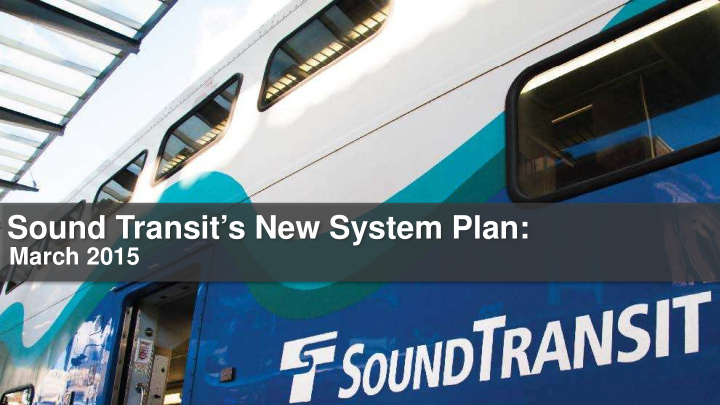



Sound Transit’s New System Plan: March 2015
Agenda • Overall Schedule Review • Examine Revised Washington Code Requirements (RCW) for ST3 Planning • Conceptual System Expansion Scenarios Development • Next Steps 2
System Plan (ST3) Timeline 3 3
RCW 81.104 (2)c Places Requirements on ST’s System Planning “Analysis methods : The local transit agency shall develop reports describing the analysis and assumptions for the estimation of capital costs , operating and maintenance costs , methods for travel forecasting , a financial plan and an evaluation methodology .” 4
Key Methodologies for System Plan Development Capital Cost Estimating Methodology : • Generate reasonable cost estimates for delivering proposed projects • Include appropriate design allowances and contingencies • Use Sound Transit experience in delivering similar types of projects Operating and Maintenance Cost Estimating Methodology: • Generate reasonable estimates of the annual cost of operating proposed transit services • Driven by system characteristics and Sound Transit operating cost experience (or based on peer systems) 5
Key Methodologies for System Plan Development Transit Ridership Forecasting Methodology: • Generate reasonable estimates of transit ridership and of transit service characteristics • Examines proposed future changes in land use and non-transit transportation conditions, • Incremental changes in the transit level of service and user costs (e.g., fares) Evaluation Methodology: • Describes how core priorities will be used to develop conceptual scenarios, priority project lists, and development the overall system plan 6
Key Methodologies for System Plan Development Financial Modeling Methodology: • Detail sources and uses of funds within financial plan • Describe methodology for forecasting key financial inputs (e.g., future tax revenues) • Document key financial planning assumptions (e.g., assumed borrowing rate). 7
RCW 81.104.080 Requires Coordination with Vision 2040 “ Regional high capacity transportation plans shall be included in the designated regional transportation planning organization's regional transportation plan review and update process to facilitate development of a coordinated multimodal transportation system and to meet federal funding requirements. ..” • PSRC administrative procedures require a Benefit-Cost Analysis for transit projects with a cost greater than $100 million. 8
Key Methodologies for System Plan Development Benefit-Cost Analysis Methodology: Comparison of quantifiable benefits and costs that can reasonably be expected to occur from the implementation of a system of HCT rail investments. Benefits: • Transit user time savings and mobility benefits for non-transit users • Auto operating and ownership cost savings; Accident reduction and safety benefit; Parking cost savings; Environmental benefits Costs: • Capital expenditures; Annual operating and maintenance costs; Periodic rehabilitation and replacement costs. 9
RCW 81.104.100 (2)b Requires HCT Options “A do-nothing option and a low capital option that maximizes the current system shall be developed. Several higher capital options that consider a range of capital expenditures for several candidate technologies shall be developed.” 10
Conceptual Scenarios: Technologies (Modes) Rapid Streetcar Bus Rapid Transit Link light rail 11
Potential Trade-offs: Length Fewer Miles More Miles Alignment Less Developed Areas More Developed Areas Profile At-grade, Shared Lanes Exclusive (Aerial/Tunnel) Supporting Projects Fewer More 12
Conceptual System Expansion Scenarios Summary More • Maximized Spine, Additional Corridor Investments Spine • Maximized Spine, Limited Additional Corridors • Most of Spine, Some Additional Corridors • Less Spine, More Additional Corridors • Modest Spine Extension, Emphasis on Additional Corridors • Medium Cost --- Progress toward Completing Spine, No Additional Corridors • Medium Cost --- Some Progress toward Completing Spine, Modest Additional Corridors • Low Cost --- Minor Progress toward Completing Spine Less • Incremental Expansion --- Using Existing Revenue Authority Spine 13
Core Priorities for System Plan Development and Evaluation • Completing the Link light rail Spine • Ridership • Connecting the region’s designated centers with HCT • Promoting transit friendly land use and supporting TOD • Advancing “Logical Next Steps” projects beyond the Spine; within financial capacity • Socio-economic equity • Integration with other transit operators/transportation systems • Multi-modal access 14
System Planning Process in 2015 CORE PRIORITIES ▼ → CONCEPTUAL SYSTEM EXPANSION SCENARIOS ← ▼ → Scenario Evaluation Measures Based on Core Priorities ← ▼ Initial Project Evaluation Measures Based on Core Priorities and Scenario Evaluation ▼ Development of Priority Projects List ▼ Project Templates ▼ Detailed Project Testing & Evaluation 15
Thank you.
(end of document)
Recommend
More recommend